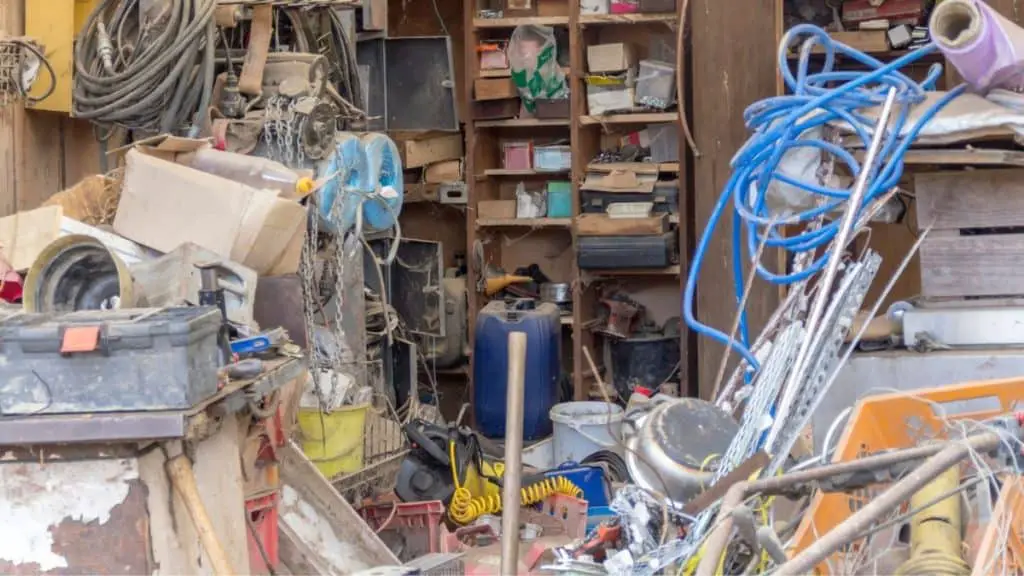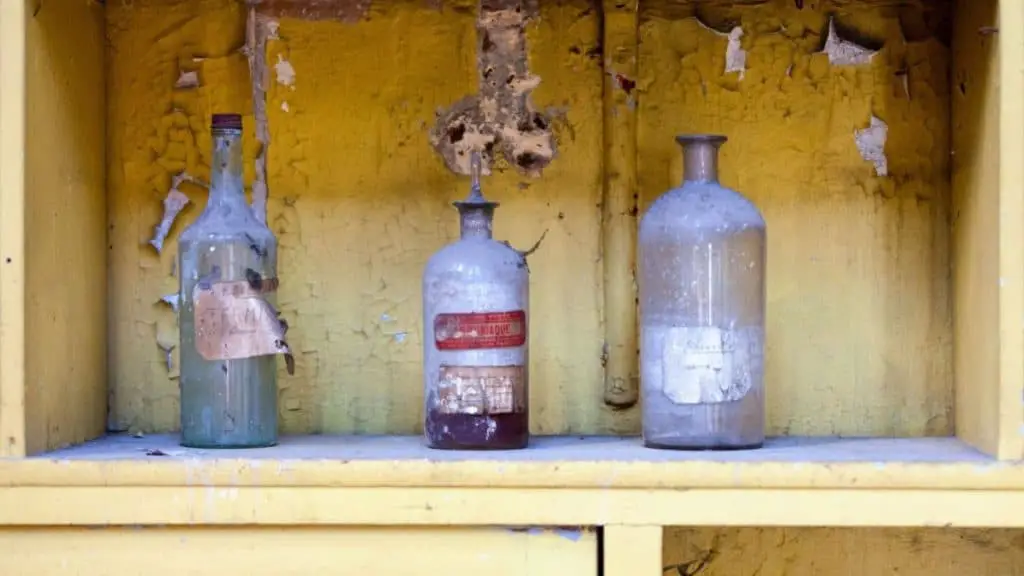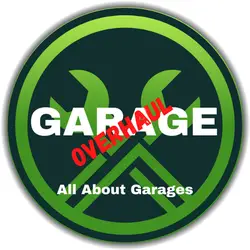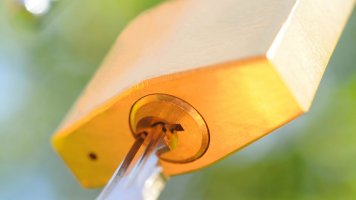Garage Dangers & Safety Hazards + (Safety Tips)
This post contains affiliate links.
What Dangers Could Exist In a Garage
Garages can be hazardous places and should not be overlooked or ignored. Garages are usually heavily used and contain many safety hazards if not properly taken care of. People die in garage accidents all too often. Severe injuries are common. Keeping the garage safe is not difficult and should be done regularly.
Garages usually contain many dangerous things like the garage door, carbon monoxide, gasoline, cars, tools, chemicals, clutter, vermins, heaters, faulty wiring, mold, and asbestos.
We go over different dangers of garage and how to make the garage safer place.
Dangers of Attached Garage
The attached garages are more dangerous than detached because an attached garage is attached to your home. In case of a fire, your house could burn down too. Also, any contaminants like carbon monoxide, chemicals, mold, or gas leaks can make their way into your home. If the garage is not appropriately sealed from the rest of the house.
Make sure the attached garage is correctly ventilated by its own system. Hire an expert to assess the situation if necessary. Seal any holes or cracks between the garage and house. And make sure to have an airtight door between the garage and house.
Don’t run the car or other vehicles inside the garage any more than absolutely necessary. Because of the carbon monoxide.
Messy Garage Issues
Cluttered and messy garages are dangerous. Many critters could lurk anywhere and bite you or your kids or pets. And it’s hard to find anything if the garage is full of junk. You could trip and hurt yourself too. Stuff could come down from overhead storage or wobbly shelves.

Also, it’s hard to see potentially broken wires or leaking pipes if the garage is too full. Many objects are also severe fire hazards. Take time off and clean the garage properly, so you have a safe environment for other usages than just storing junk.
Invest in storage systems like cabinets(paid link), overhead storage(paid link), and wall systems and shelves(paid link). Try the keep the garage floor clear at all times.
Insufficient Lighting in the Garage
Too dark garages or workshops can be dangerous. You could trip on something on the floor or hard to see steps. Operating tools in insufficient lighting can be hazardous too. You could hurt yourself badly.
If your garage has old-school fluorescent tubes and few incandescent bulbs, maybe it’s time to upgrade them to modern LED lights. Use portable lights, at least. If you use the garage a lot or have a workshop. Investing in proper lighting is wise.
If you’re interested in the best garage lights you can find them on Amazon or read article about good garage lights here.
Dangerous Garage Door Malfunctions
Garage doors are the biggest moving objects in your house and could be dangerous if something does not work as intended. Test the door functions regularly, such as sensors, springs, tracks, rollers, and emergency release.
Sensors
Garage opener sensors are a safety feature for the garage doors, so they don’t close onto somebody or something.
If garage door sensors don’t work correctly, the garage door might come down to your kids, pets, or car, and someone could be injured very badly. Always make sure your sensors work correctly and call an expert to inspect them if you can’t fix the problems yourself. Garage door sensors are essential safety equipment in the door and the opener.
Read more about testing the sensors here.
Tracks & Rollers
Make sure the garage door rollers(paid link) and tracks are always in working order. If rollers break, the door could jam badly or even come off the tracks, and somebody could get hurt. Change the broken rollers and adjust the tracks if you notice anything wrong or call an expert.
- Close the door.
- Disconnect the opener first using an emergency release cord.
- Try operating the door in manual mode by opening and closing the door couple of times.
- Look for symptoms of loose rollers or misaligned tracks.
Read more about common garage door & opener problems here.
Emergency Release Cord
Always make sure the emergency release is working correctly. It disconnects your garage door opener from the door, so you can operate the door manually. You don’t want to be trapped in the garage in case of fire or power outage.
How to Use Emergency Release
Close the Door
- The door must be closed before you pull the emergency release cord. Disengaging the door in up position can be dangerous, and the door could come crashing down. IF the springs are broken or poorly adjusted.
Pull the Emergency Release Cord
- This is a red rope that hangs from the door trolley. Pull it, and it disconnects the trolley from the opener. Now you can manually open or close the garage door.
Re-Connecting the Trolley
- Align the trolley and garage door arm. You can use a remote or if the power is out, operate the door manually.
- Pull the emergency release cord down and toward the door. You should hear a loud click. In some models, you have to pull the trolley towards the opener.
Dangers of Garage Door Springs
Garage door springs can be very dangerous if you are near them when they break. That’s because they are under incredible tension, and when they fail, metal bits can fly anywhere. You usually hear the spring breaking in the garage if you are inside the house. It is a loud noise.
Also, if the spring breaks, the garage door will not operate properly and can be very heavy to lift by hand, and you could be trapped in the garage in case of a power outage.
There are two types of springs, extension and torsion springs. A gap in both types means the spring is broken and needs to be replaced.
Dangers of Garage Heaters
There are many types of garage heaters, and malfunction can cause a fire in a worst-case scenario. Any kind of portable heaters should not be left unsupervised. They could tip over and start a fire. Also, suppose the garage is very dusty, or you do woodworking or painting. In that case, you have to buy or install a heater that is up to the task. And won’t ignite the particles in the air.
- Any open flame heater poses a higher fire risk.
- A forced air heater will stir up particles in the air.
Look heaters with safety features such:
- Tip-over switch: This switch automatically turns the heater off when it’s tipped over or if there is an operational failure
- Thermostats: A built-in thermostat will switch the heater off if it identifies the oxygen is below a certain level
- Automatic shutoff in case of high temperatures
- Cool-touch body: If you accidentally touch the heater, it won’t burn you.
Garage Heater Safety
- If you suspect a leak, switch off the gas supply at the source when it’s safe to do so. Don’t use lighters or anything else that can produce a spark.
- If you smell gas, oil, or other fumes in your garage, don’t ignite a heater.
- For portable heaters, don’t place them in high-traffic areas. Keep them away from animals and children.
- Don’t place the heater near items that are easily flammable when they get hot.
- Don’t use extension cords with heaters. They are prone to getting hot and causing shorts.
- Clean the heater periodically to prevent dust and debris from building up and catching fire.
- Purchase a heater that is suited for indoor purposes
- Switch off the heater as soon as you’re done using it
- Heaters that use open flames. Keep flammable liquids or sprays away from them.
- Don’t leave your heater unattended.
- Don’t move the heater while it’s on. Switch it off and wait for it to cool down. Then it’s safe to move it.
Combustion heaters produce carbon monoxide. They should never be used without opening your garage door several inches and/or opening windows to create ventilation. They should also never be used inside your home. Even in well-ventilated garages, you should install a carbon monoxide detector for added safety.
Check out the best garage heaters here.
If you’ll be working on wood projects or using spray finishes, choose a heater with a separate combustion chamber. They burn fresh outside air instead of the dust or paint-laden air inside a garage.
Faulty Garage Wiring
Faulty wiring poses a fire hazard. Inspect the wiring regularly for any damage. Critters could chew the wiring, or wires could take a beating accidentally from work you do in the garage. Change the damaged wiring or call an expert if you think something is wrong with the wiring.
- Inspect also any other electric components.
- Electrical malfunctions and garage heaters are the leading cause of garage fires.
- A strange fishy smell can tell failing electrical components. Electrical shielding, wires, and components emit a fishy smell when they overheat.
- Check your outlets and other electrical components for equipment that looks burnt or melting if there is a sign of any malfunction. Don’t touch them !!
- Switch off the electricity from that part of the house and call an expert immediately. Failing electrics form a severe fire hazard.
- Burning plastic, wiring, and electrics can smell like rotten eggs too.
- Garages can be cold and damp without heating and insulation. Use outdoor extension cords and power strips in such a case.
- Never overload electrical outlets.
- All garage circuits should be protected with a GFCI (ground fault circuit interrupter)(paid link)
Dangerous Critters in Garage
Many dangerous pests and critters like to live in a garage and could pose a health hazard for your family members and pets. Some dangerous spiders and snakes could be fatal if someone gets bitten.
Keeping the vermins out of the garage is essential in some regions of the world, and even simple mice can ruin your stuff and electric wires. Mouse and rat excrements can also contain viruses or bacteria.
Keep the garage clean, all access points sealed, and any food stored in closed containers goes a long way in keeping the unwanted quests out.
Check this and this article on how to keep the most common garage vermins out.
Dusty Garage
Dusty garage poses a fire and health hazard. The garage needs to be cleaned regularly, same as your house. Dust collects quickly in garages, especially if you have an unsealed concrete floor in your garage. The concrete will wear over time and produce dust.
It is advisable to seal the concrete at least or think about some other flooring options. Cleaning the garage from years of dust is at least one day job. Pick a good day and empty the garage outside. Get help, too, so the job goes faster. It is a good time too to sell, donate and throw stuff away.
Read about cleaning the garage properly in this article.
Oil in Garage Floor
Oil and grease stains are inevitable in a garage. Vehicles, lawnmowers, and other equipment leak fluids. Oil on the garage floor is dangerous for obvious reasons. You could slip on it, and it could catch fire. Always clean oil spills right away.
Unsealed concrete has a nasty habit of sucking up any fluid quick.
- If the spill is fresh, use sawdust, cornmeal, cat litter to absorb the liquid or oil absorbent pads(paid link). Leave them to suck up the liquid for about 24h hours and sweep it up.
- After sweeping, you can try dish soap or laundry detergent into the stain. Let them sit for about an hour. Pour little water and scrub the area with a nylon-bristle brush. Rinse and repeat. Finish it off with just water.
- Mix TSP (Trisodium phosphate)(paid link) and water. Wear gloves, safety glasses and other protective equipment(paid link). Pour the solution to stains and scrub. Rinse with water.
- WD-40 also removes oil stains from concrete. Get most of the oil off the first, saturate the stain with WD-40 and let it soak for about 10 minutes. Wipe off with a rag and use dish soap and water to finish it off.
Water in Garage
Water in garage floors can freeze in cold temperatures, and you could slip on ice. Water can come through broken weather seals. Inspect the seals all around the garage door. Inspect the roof, too, for leaks.
Leaking pipes also create water damage fast in the garage. Moisture in the wood or drywall or insulation will create mold and mildew fast. Some mold types are dangerous when inhaled and pose a severe health hazard. Always inspect the garage pipes, drains, and sinks for any leaks.
If you suspect a leak in the pipes. Get an expert to assess the damage and take moisture readings from the walls and ceiling.
Storing Dangerous Chemicals in Garage
Dangerous chemicals like pesticides, rat poisons, car fluids, pool products, paints, and thinners, or industrial cleaners should be kept in locked cabinets(paid link) away from kids and pets. Always store chemicals in their original container. Make sure the chemical containers are airtight and sealed to avoid chemicals releasing VOCs (volatile organic compounds) or other things that will evaporate into the air.

Keep the road salt and ice melt mixtures off the floor and in tightly sealed containers and away from easy access.
Also, make sure the garage is properly ventilated, and nothing evaporates inside your home. Seal all the holes in the garage that lead to your home. Really dangerous chemicals should be kept in a shed or detached garage.
Storing Gasoline in Garage
You should not store large amounts of gasoline in your garage. (usually no more than 5 gallons) Gasoline is an obvious fire hazard. If you have heaters or appliances with pilot light. Don’t store the gasoline in the same space.
Suppose you store gasoline for lawnmowers, garden tools, or other equipment. Ensure the gas is in tightly sealed plastic containers or metal tanks made for the purpose and marked clearly. Also, gasoline should be kept in a detached garage, tool shed, or storage barn and away from any ignition sources, including hot water tanks and radiators.
Read more here what is safe to store in the garage and what not.
Propane Tanks in a Garage
Propane tanks should be stored outside in a shed or a detached garage. The tanks can leak and pose a fire and health hazard. Never store propane inside the garage. Propane has a very high freezing point (-306 degrees F / -187C) and can be stored outside.
Manufacturers add chemicals to natural gas and propane to give it a noticeable odor. It will smell like rotten eggs. They are naturally colorless and odorless.
The smell is a safety precaution! Vacate the premises immediately and call an emergency number.
Asbestos in Garages
During 1930-1970 asbestos was widely used to construct garages in building materials like roofing shingles, insulation, drywall, ceiling, floor tiles, and asbestos cement.
Asbestos fibers can be released into the air if asbestos-containing material is disturbed during building maintenance, repair, or remodeling. In general, asbestos exposure can occur when asbestos-containing material is damaged or disturbed in a way that releases particles and fibers into the air. Exposure to any type of asbestos can lead to cancers and other illnesses. You can’t feel, see, or taste asbestos.
Older asbestos-containing products can become exposed from damage, wear-and-tear or other disturbances. For example, buildings and homes built before 1979 in the USA likely contain asbestos materials that haven’t been replaced or removed.
If the area containing asbestos is in good condition, leave it alone. The worst thing you can do is disturb the area and release asbestos fibers unknowingly. So, take note of any places you think or know may have asbestos materials, and leave them alone.
If you notice or know of areas with damaged asbestos-containing materials, stay away from them and call the experts to deal with the problem areas.
Suppose you are planning more extensive repairs, maintenance, or remodeling of your garage or home. In that case, you need to contact the experts to check out if the building materials contain asbestos. Never touch, move or dispose of asbestos-containing material on your own.
Worldwide, 67 countries, including the United Kingdom, Australia, Canada, and all 28 countries of the European Union, have banned the use of asbestos. The United States has extensive laws regulating the use of asbestos.
Mold in Garage
Cardboard and paper soak up moisture and starts to grow mold fast. Leaking pipes also create water damage quickly in the garage. Moisture in the wood or drywall or insulation will create mold and mildew fast. Some mold types are dangerous when inhaled and pose a severe health hazard. Always inspect the garage pipes, drains, and sinks for any leaks.
If you suspect a leak in the pipes. Get an expert to assess the damage and take moisture readings from the walls and ceiling.
Some types of molds are dangerous to inhale for more extended periods and can make people very sick. Some molds are only cosmetic and not harmful. If you have doubts, get an expert to assess the situation.
Carbon Monoxide in Garage
Carbon monoxide doesn’t smell like anything and can be deadly. Sources of CO in a home can include.
- Fireplaces
- Space heaters
- Gas and wood stoves
- combustion engines
Using kerosene heaters or charcoal grills indoors or running a car in a garage can cause CO levels to rise high enough to result in death or severe illness.
- Always back your car out of the garage to let it warm up. Never leave it running in the confined space of a garage, particularly if the garage is attached to the home.
- Never run lawnmowers, snowblowers, or other gas-powered engines in confined areas like garages or sheds.
- Never use ovens or grills to heat your home or garage.
Make sure your home has at least one CO detector(paid link). Preferably more. Put one on your garage also, at least temporarily, if it goes off when you have not been running any vehicles in the garage. It could be a sign of a failing furnace or gas water heater. Also, learn how to operate fireplaces and wood stoves properly. Install smoke detectors too.
Workshop in Garage
Workshops in a garage can be very dangerous places and deadly for kids and pets and should be locked at all times to avoid accidents. Make sure your workshop is a safe area for you to work. Install adequate lights and take care of the ventilation. Take care of the equipment and tools and make it very clear to your family that the workshop is off-limits without your supervision.
- Don’t leave the machines unattended.
- Make sure the safety guards and screens on equipment work.
- Install adequate ventilation.
- Install proper safety signs.
- Keep clutter away from workstations.
- Make enough space.
- Use safety equipment when dealing with chemicals and dangerous work.
Common types of personal protective equipment(paid link) in workshops include eye protection, hearing protection, gloves, respiratory protective equipment (like masks), and overalls. Have a first aid kit(paid link) and extinguisher(paid link) close at hand.
Dangerous Tools in Garage
Dangerous tools should be kept in lockable cabinets and off the floors to avoid accidents. Unplug power tools when not in use. Clean the tools and sharpen the blades often.
For larger tools like a bandsaw or a table saw. Make sure the locking mechanisms work as intended. You can also disconnect the stationary tools from the power supply when they are not in usage.
Yard tools are often sharp and should not be left lying around. Invest in a wall storage system and keep the blades facing the wall.
Car Dings
Messy and poorly lit garages often result in car dings. Dings will hurt even more if they happen to your precious museum or project car you only drive rarely. Luckily nowadays, there are many ways to prevent car dings efficiently.
Check out this article to find out how to prevent car dings.
Car Rusting
Cars can rust in a garage faster if you live in a cold climate where you have lots of snow and slush, and you keep your vehicle in a heated garage during the winter. Road salt is a big problem for cars, and if you drive during the winter, it’s wise to wash the car often.
- The salt-filled snow and slush that sticks to your car are bad, but it’s not that serious if it remains frozen.
- When you park your car in the garage, even if it isn’t heated, the slush can melt from the engine’s heat. The water that results from the melted slush increases the rust-causing properties of the salt. That can lead to additional rust damage than if the car remained outside.
- The dampness in your garage does not soon evaporate because of winter’s cooler temperatures and the lack of ventilation. That means your car can be wet for more extended periods than it is dry. That prolonged wetness gives salt more time to do its dirty work.
- Every time you take your car out and bring it back in again, the whole corrosion-causing process repeats itself.
Read more about car rusting in here.
Dangers of Grilling in the Garage
If the weather is terrible, many people want to barbeque inside the garage.
Don’t grill inside the garage even if the door is open. Using a charcoal grill, propane grill, or gas grill, grilling inside your garage is not an option.
Dangers include:
- Carbon monoxide poisoning from charcoal grills, burning wood, gas, or propane grills.
- Improper ventilation.
- Accidents with the grill or gas bottle.
- Garages are usually full of fire hazards.
Use electric grills only to grill indoors. Electric grills(paid link) are designed for use indoors without exposing you to any risks.
Dangers of Sleeping in Garage
Sleeping in a garage is a bad idea. There is always a risk of carbon monoxide poisoning. Some chemicals can release VOC (volatile organic compounds) if space is not adequately ventilated. Garages can be cold, too, if they are not insulated and heated. There can also be a lot of moisture. Garages can be drafty and damp.
You might also share the space with spiders, bugs, mice, and other vermins that can bite you.
The garage needs to be adequately converted to a living space before its recommended sleep in the space. Read also about living above the garage here.
Garage Safety Tips
- Mark the garage stairs edges with reflective tape and keep them clutter-free. More than 30% of slips and falls happen on garage stairs. Install a sturdy handrail too.
- Keep the garage clean, organized, and clutter-free.
- Store everything in their own places and, if needed, locked away.
- Upgrade the garage lighting at least near work areas and stairs or use portable lamps.
- Anything that might contain a fire hazard or is flammable, or poses a threat to fire safety or security follows the guidelines and provisions published by the National Fire Protection Agency (NFPA).
- Store oil, gasoline, propane, and other highly flammable materials in the outside shed if possible.
- Garages can be cold and damp without heating and insulation. Use outdoor extension cords and power strips in such a case.
- Mount the garage door opener wall button above the reach of small children.
- Clean any oil or antifreeze spills off right away—store antifreeze in a locked container.
- Don’t let your kids play near the door when it’s coming down, or let them hang in the door as it’s going up.
- Lock your vehicles when they are parked in the garage, and store the keys out of reach of children.
- Test the garage door in manual operating mode at least once a year. Make sure the rollers and tracks work unobstructed. Test the spring balance is adjusted correctly and make sure the emergency release works as intended.
- Test the garage door sensors work properly
- Install smoke, heat, and carbon monoxide detectors in the garage and to the house.
- Don’t overload an outlet with multiple plugins.
- Ensure your garage has a fire extinguisher rated A-B-C. that type of extinguisher(paid link) can handle all types of fires.






